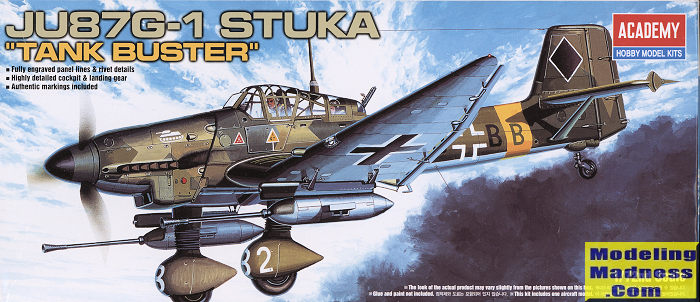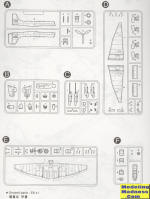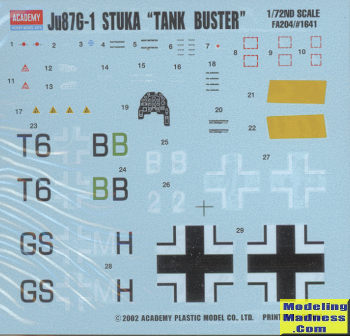
Academy 1/72 Junkers Ju-87G-1 'Tank Buster'
| KIT #: | 12450 |
| PRICE: | $12.00 or so |
| DECALS: | Two options |
| REVIEWER: | Scott Van Aken |
| NOTES: |

| HISTORY |
With the G variant, the ageing airframe of the Ju 87 found new life as an anti-tank aircraft. This was the final operational version of the Stuka, and was deployed on the Eastern Front.
The reverse in German military fortunes after 1943 and the appearance of huge numbers of well-armoured Soviet tanks caused Junkers to adapt the existing design to combat this new threat. The Henschel Hs 129B had proved a potent ground attack weapon, but its large fuel tanks made it vulnerable to enemy fire, prompting the RLM to say "that in the shortest possible time a replacement of the Hs 129 type must take place." With Soviet tanks the priority targets, the development of a further variant as a successor to the Ju 87D began in November 1942. On 3 November, Erhard Milch raised the question of replacing the Ju 87, or redesigning it altogether. It was decided to keep the design as it was, but the power-plant was upgraded to a Junkers Jumo 211J, and two 30 mm (1.2 in) cannons were added. The variant was also designed to carry a 1,000 kg (2,200 lb) free-fall bomb load. Furthermore, the armoured protection of the Ilyushin Il-2 Sturmovik—a feature pioneered by the 1916–17 origin Junkers J.I all-metal sesquiplane of World War I Imperial Germany's Luftstreitkräfte—was copied to protect the crew from ground fire now that the Ju 87 would be required to conduct low level attacks.
Hans-Ulrich Rudel, a Stuka ace, had suggested using two 37 mm (1.46 in) Flak 18 guns, each one in a self-contained under-wing gun pod, as the Bordkanone BK 3,7, after achieving success against Soviet tanks with the 20 mm MG 151/20 cannon. These gun pods were fitted to a Ju 87 D-1, W.Nr 2552. The first flight of the machine took place on 31 January 1943, piloted by Hauptmann Hans-Karl Stepp. The continuing problems with about two dozen of the Ju 88P-1, and slow development of the Henschel Hs 129B-3, each of them equipped with a large, PaK 40-based, autoloading Bordkanone 7,5 7.5 cm (2.95 in) cannon in a conformal gun pod beneath the fuselage, meant the Ju 87G was put into production. In April 1943, the first production Ju 87 G-1s were delivered to front line units. The two 37 mm (1.46 in) Bordkanone BK 3,7 cannons were mounted in under-wing gun pods, each loaded with two six-round magazines of armour-piercing tungsten carbide-cored ammunition. With these weapons, the Kanonenvogel ("cannon-bird"), as it was nicknamed, proved very successful in the hands of Stuka aces such as Rudel. The G-1 was converted from older D-series airframes, retaining the smaller wing, but without the dive brakes. The G-2 was similar to the G-1 except for use of the extended wing of the D-5. 208 G-2s were built and at least a further 22 more were converted from D-3 airframes.
Only a handful of production Gs were committed in the Battle of Kursk. On the opening day of the offensive, Hans-Ulrich Rudel flew the only "official" Ju 87 G, although a significant number of Ju 87D variants were fitted with the 37 mm (1.46 in) cannon, and operated as unofficial Ju 87 Gs before the battle. In June 1943, the RLM ordered 20 Ju 87Gs as production variants. The G-1 later influenced the design of the Fairchild Republic A-10 Thunderbolt II, with Hans Rudel's book, Stuka Pilot being required reading for all members of the A-X project.
| THE KIT |
 Pretty
much every major kit producer has provided us with a Ju-87 of some variant or
another and the G-1 is often included in their catalog. So it is with Academy. A
common feature of these kits is that the engine portion of the fuselage is
always separate so that the different engines can be used, for the fuselage
remained fairly constant throughout the type's existence.
Pretty
much every major kit producer has provided us with a Ju-87 of some variant or
another and the G-1 is often included in their catalog. So it is with Academy. A
common feature of these kits is that the engine portion of the fuselage is
always separate so that the different engines can be used, for the fuselage
remained fairly constant throughout the type's existence.
The kit's interior is standard 1/72 stuff with seats, bulkheads, gunner's position and a control stick for the pilot. The rudder pedals are molded into the floor. There is fairly good sidewall detail inside the fuselage halves. A decal is used on the instrument panel. As mentioned, the engine piece is separate and one simply installs the radiator before closing it up. The prop and spinner can be added after painting as can the exhaust.
Once the fuselage halves and engine assembly are together, a pair of upper fuselage inserts can be installed. The wing is a lower section with two upper halves. Pretty standard stuff. Certain holes in the lower wing need opened for the guns. The G-1 has no dive brakes and these are not included in the kit. Once gun fairings are attached to the assembled wing, it can be glued in place. Same for the tailplanes, which take end caps. The horizontal stabs also take struts, but these can be added after painting if one wishes.
Main gear are in halves that trap the main wheel. Tail gear
includes  the
wheel. One adds the lower wing radiators and after assembling the gun pods,
those are also attached. Note that while the ailerons and flaps are attached to
the lower wing, you still have to glue on all the little actuating hinges and
the aileron mass balances. This would be the fiddly part. Academy provides you
with the option for a single piece greenhouse or one where you can have the
various sections separate. I'm guessing the plastic is too thick to properly
pose the cockpit canopy open so I'm not really sure why the option is even
provided. Thanks to the rear machine gun, you'll have to mask and paint this
prior to permanent installation.
the
wheel. One adds the lower wing radiators and after assembling the gun pods,
those are also attached. Note that while the ailerons and flaps are attached to
the lower wing, you still have to glue on all the little actuating hinges and
the aileron mass balances. This would be the fiddly part. Academy provides you
with the option for a single piece greenhouse or one where you can have the
various sections separate. I'm guessing the plastic is too thick to properly
pose the cockpit canopy open so I'm not really sure why the option is even
provided. Thanks to the rear machine gun, you'll have to mask and paint this
prior to permanent installation.
| CONCLUSIONS |
By all accounts, this is a very nice kit. Nicer than the Fujimi version, but as always, the test is in the building so we shall see. This kit is widely available and is not expensive so well worth considering.
| REFERENCES |
https://en.wikipedia.org/wiki/Junkers_Ju_87#Ju_87G
November 2019 Copyright Modelingmadness.com. All rights
reserved. If you would like your product reviewed fairly and fairly quickly, please contact the editor or see other details in the
Note to
Contributors. Back to the Main Page
Back to the Review
Index Page
Back to the Previews Index Page